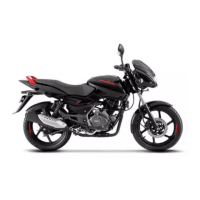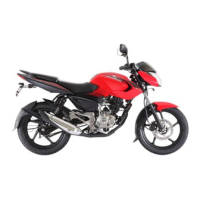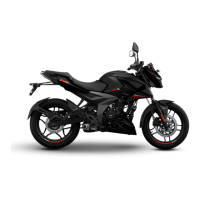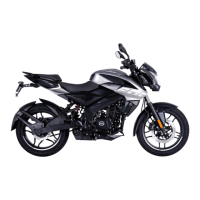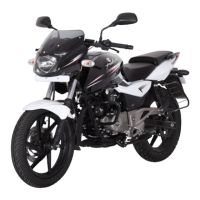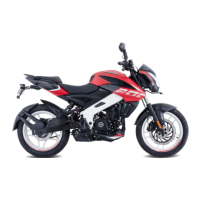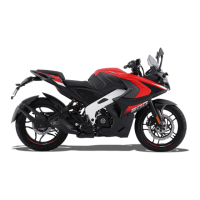Dealer Development Center, Pune
64
Pulsar DTS-i 150/180 Training Notes
Maintenance - Electrical
Battery DC Charging current : (Use fully
charged battery ensuring battery voltage =
12.5 + 0.3 V before measuring)
To measure the DC charging current, set the
meter at 20ADC. Connect meter+ve lead to
White/black lead from RR Unit and meter -ve
lead to battery +ve lead.
Start the engine and set it at 4000+25 RPM.
Measure the DC charging current. The DC
charging current should be 0.7 A max stop the
engine and disconnect meter leads. Connect the
RR unit and battery.
Meter
Range
Connection Specification
DC10A
Meter +ve
White/Black
terminal of
R/R
Meter -ve
Battery (+)
lead (White)
0.7 A max
at 4000+25
RPM
Note :
Connect multi meter in series with the circuit
while conducting above test.
DC Charging Voltage Measurement : (Use
fully charged battery while measuring)
To measure the DC voltage; set the meter at
20VDC range. Connect the meter +ve lead to
white from RR unit and meter -ve lead to
ground. Start the engine and set it at 4000+25
RPM. Measure the voltage with and without
headlight switch to the ON position. Stop the
engine disconnect the meter leads.
Meter Range
Specification at 4000+25 RPM
DC 20 Volt
14.3 to 14.7 V
Multimeter connected in
Parrallel with Battery for
checking DC charging
voltage
L/W
L/W
MAGNETO
R
W/B
L/W
L/W L/W
L/W
W
W
W
W
W
CAPACITOR
REGULATOR
WITH CAPACITOR
W
FUSE
(10 Amps.)
STARTER RELAY
100A RATING
BATTERY
12V-9Ah
W
B
14.3
Dealer Development Center, Pune
65
Pulsar DTS-i 150/180 Training Notes
Measuring & Testing Equipment : Multimeter
Fuel Gauge - Tank Unit
200 Ohms
Meter Range
As per chart
given below
White / Yellow
Meter +ve
Connections
Black / Yellow
Meter -ve
Standard Value
Empty Tank
Note: Before checking the above, please confirm
• Battery Voltage
• Speedometer coupler & fuel gauge tank unit coupler connection is
firm.
Standard Value : (For 150 CC)
Fuel Level Fuel Quantity Standard value Graphical Bar on
Instrument cluster
Empty Tank 1.25+0.3 Liter 93~101 Ohm 0 Bar
Reserve 2.8 Liter 67~77 Ohm 2 Bars
Just Above Reserve 3.5 Liter 58~62 Ohm 3 Bars
Half Tank 4.5 Liter 36~44 Ohm 4 Bars
Full Tank 8.5 Liter 6~10 Ohm 6 Bars
Full Tank
Note: Before checking the above, please confirm
• Battery Voltage
• Speedometer coupler & fuel gauge tank unit coupler connection is
firm.
Standard Value : (For 180 CC)
Fuel Level Fuel Quantity Standard value Graphical Bar on
Instrument cluster
Empty Tank 1.25+0.3 Liter 93~101 Ohm 0 Bar
Reserve 2.8 Liter 67~77 Ohm 2 Bars
Just Above Reserve 3.5 Liter 58~62 Ohm 3 Bars
Half Tank 4.5 Liter 36~44 Ohm 4 Bars
Full Tank 8.5 Liter 6~10 Ohm 6 Bars
Checking Method :
• Touch +ve wire of capacitor to earth. Spark will occur.
• This Indicates capacitor is OK.
Capacitor is very important for Battery charging function, so ensure
capacitor coupler is always firmly connected.
Note:
Capacitor
Maintenance - Electrical
Multimeter connected
in Series with Battery
for checking DC
charging Current
L/W
L/W
MAGNETO
R
W/B
L/W
L/W L/W
L/W
W
W
W
W
W
CAPACITOR
REGULATOR
WITH CAPACITOR
W
FUSE
(10 Amps.)
STARTER RELAY
100A RATING
BATTERY
12V-9Ah
W
B
7
.0

